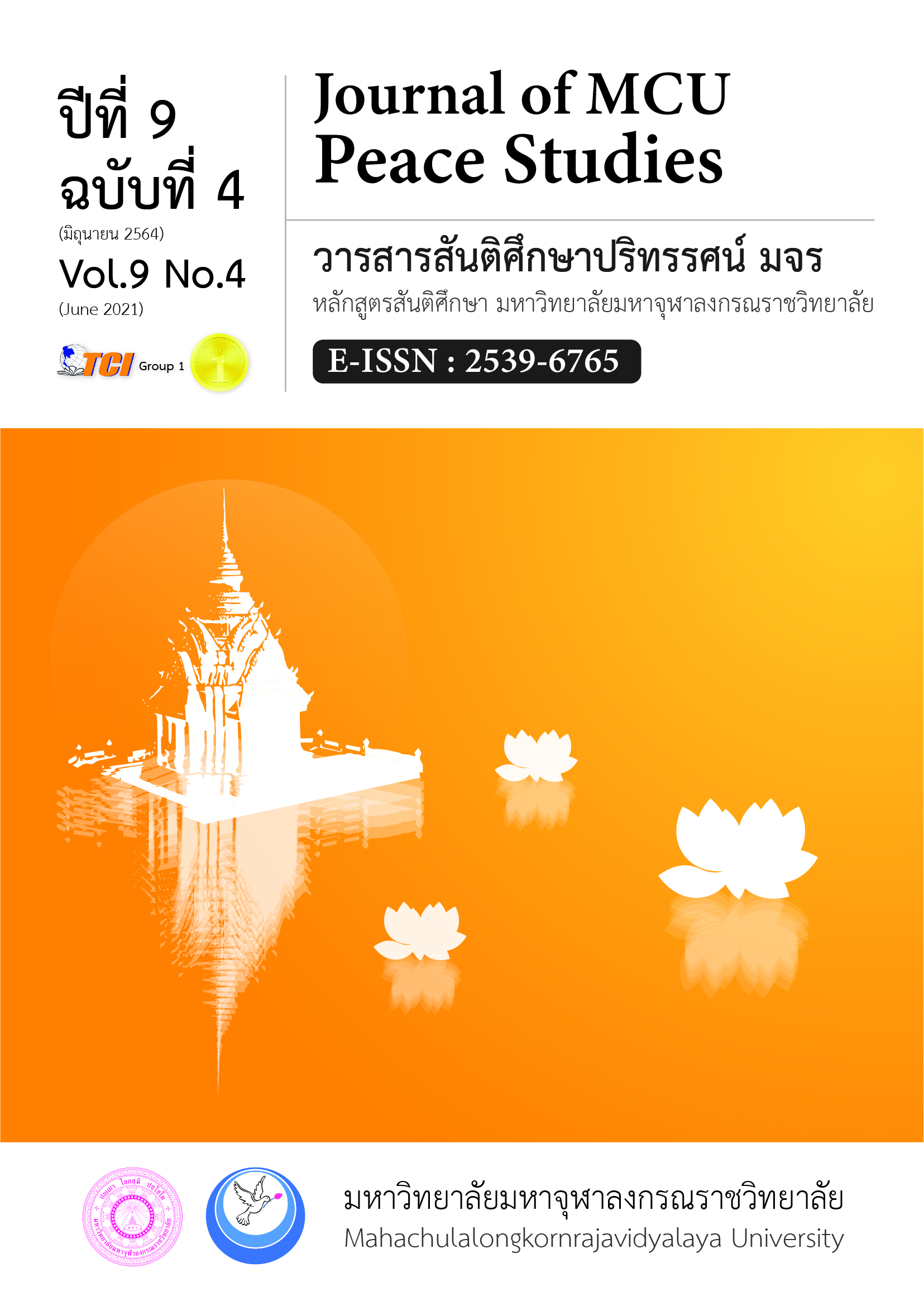การศึกษาองค์ประกอบความผูกพันในครอบครัวของวัยรุ่น
Main Article Content
บทคัดย่อ
บทความวิจัยนี้มีวัตถุประสงค์เพื่อศึกษาองค์ประกอบความผูกพันในครอบครัวของวัยรุ่น ใช้รูปแบบ การวิจัยเชิงปริมาณ ตัวอย่างที่ใช้ในการศึกษา คือ นักเรียนระดับชั้นมัธยมศึกษาปีที่ 1-3 ปีการศึกษา 2562 จำนวน 1,000 คน เครื่องมือวิจัยที่ใช้ในเก็บข้อมูลคือแบบวัดความผูกพันในครอบครัวของวัยรุ่น มีค่าความเชื่อมั่นที่ .94 การวิเคราะห์ข้อมูล ได้แก่ การวิเคราะห์โครงสร้างความสัมพันธ์เชิงยืนยัน การวิเคราะห์สหสัมพันธ์แบบเพียร์สัน ค่าส่วนเบี่ยงเบนมาตรฐาน ค่าเฉลี่ย และค่าร้อยละ ผลการวิจัยพบว่า องค์ประกอบเชิงยืนยันความผูกพันในครอบครัวของวัยรุ่น ประกอบด้วยความเข้าใจซึ่งกันและกัน สัมพันธภาพในครอบครัว กิจกรรมร่วมกัน การเผชิญปัญหา การเคารพตนเอง เอกลักษณ์แห่งตน และวินัยครอบครัว ความสอดคล้องระหว่างองค์ประกอบกับข้อมูลเชิงประจักษ์ในดัชนีกลุ่มสัมบูรณ์พบว่าค่า Chi-square 1689.59, DF=1040, P=0.08, ค่า GFI=0.99, ค่า AGFI=0.95, ค่า RMSEA=0.04, ส่วนในดัชนีกลุ่มเปรียบเทียบ ค่า CFI=0.97 เมื่อพิจารณาเกณฑ์ความสอดคล้อง พบว่า ค่า Chi-square ไม่มีนัยสำคัญทางสถิติและดัชนีอื่น ๆ ชี้ให้เห็นว่าโมเดลมีความสอดคล้องกับข้อมูลเชิงประจักษ์
Article Details
ทัศนะและความคิดเห็นที่ปรากฏในบทความในวารสาร ถือเป็นความรับผิดชอบของผู้เขียนบทความนั้น และไม่ถือเป็นทัศนะและความรับผิดชอบของกองบรรณาธิการ ยินยอมว่าบทความเป็นลิขสิทธิ์ของวารสาร
เอกสารอ้างอิง
Children and Youth Council of Thailand. (2015) . Royal speech by His Majesty King Bhumibol Adulyadej Bestowed on the occasion of the International Children's Year, 1 January 1979. Retrieved August 28, 2018, from https://cyct.dcy.go.th/
Dinkmeyer, D., Sr., G. D., & McKay, Jr. (1997). Systematic Training for Effective Parenting [VHS]. Circle Pines, MN: American Guidance Service.
Joreskog, K. G., & Sorbom, D. (1993). Structural equation modeling with the Simples command language. Chicago: Scientific Software.
Maria, C. R. M. (2006) . Loneliness and Depression in Middle and Late Childhood: The Relationship to Attachment and Parental Styles. The Journal of Genetic Psychology, 167(2), 189-210.
Office of the National Economic and Social Development Board. (2012). Population projections for Thailand 2010 - 2040. Retrieved December 15, 2018, from https://www.nesdb.go.th.
Powel, G. R. (1963). Child and Adolescent Psychology: Behavior and Development. Pregnancy Nursing Research, 30(4), 281- 284.
Resnick, M.D., Harris, K.M., & Blum, R.W. (1997). The impact of caring and connectedness on Review of the infant-Mother. Relationship Child Department, 40, 969-1025.
Rodger, J. (1996). Family Life and Social Control A Sociological Perspective. London: Macmillan.
Rodkhamdee, P. (2010). Expression of the bond between mother and child. Retrieved August 21, 2019, from http://www.ecitizen.go.th/view.php?SystemModuleKey=&id=287.
Saengsingkeaw, F. (2000). The Affection of Love in the Family. Journal of the Psychiatric Association of Thailand, 45(1), 1-10.
Sereetrakul, W. (2009) . Factors Affecting Family Solidarity as Perceived by Thai Adolescents. (Doctoral Dissertation). Ramkhamhaeng University. Bangkok.
Siriwanbut, P. (1997). Family psychology. (4th ed.). Bangkok: Chulalongkorn University Press.
Skinner. (1995). FAM-III: Family Assessment Measure version III. New York: Multi-Health System.
Tabachick, Barbara G., & Fidell, Linda S. (2014). Using Multivariate Statistics Pearson New International Edition. New York: Pearson.
Yohlao, D. (2002). Strong family, healthy family. Journal of Behavioral Science. Department of Counseling Psychology Master of Science, 45(8), 1-10.


